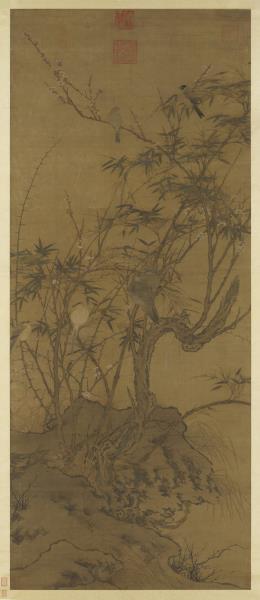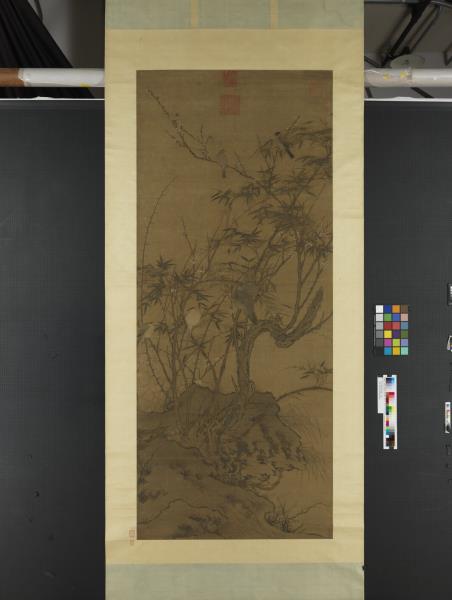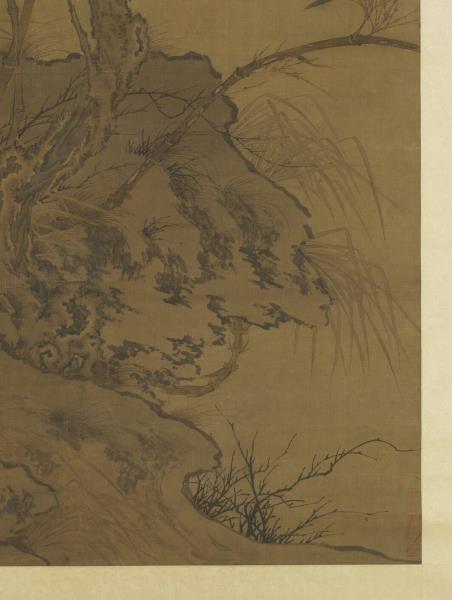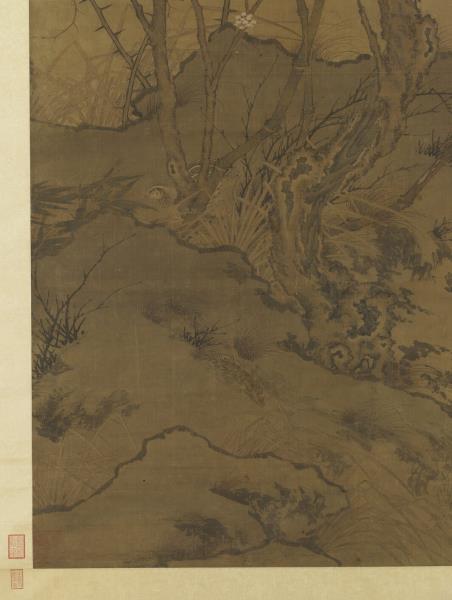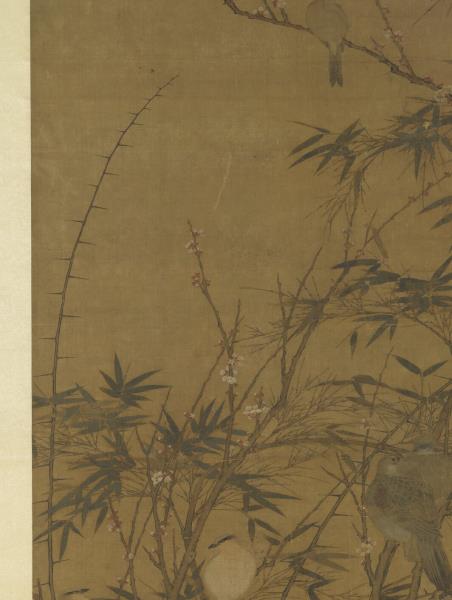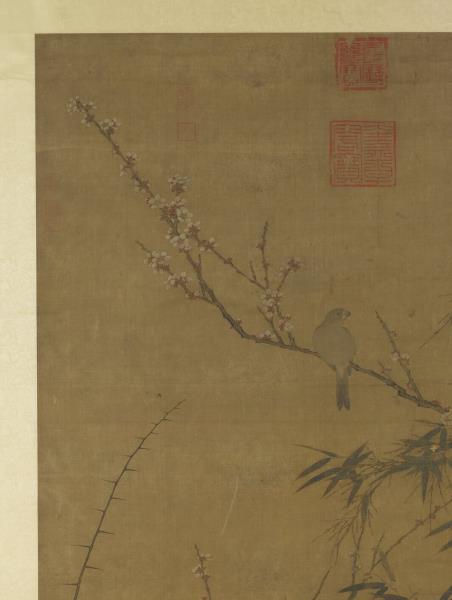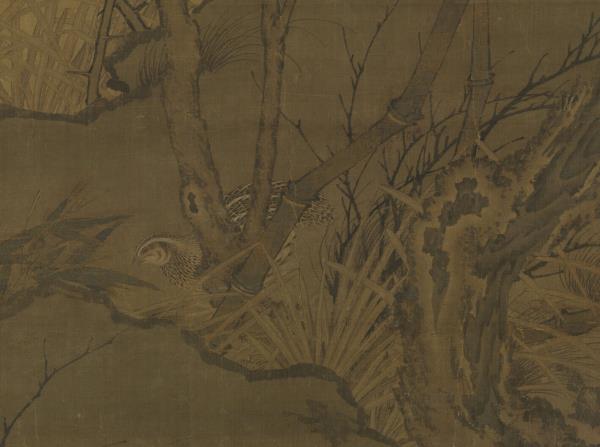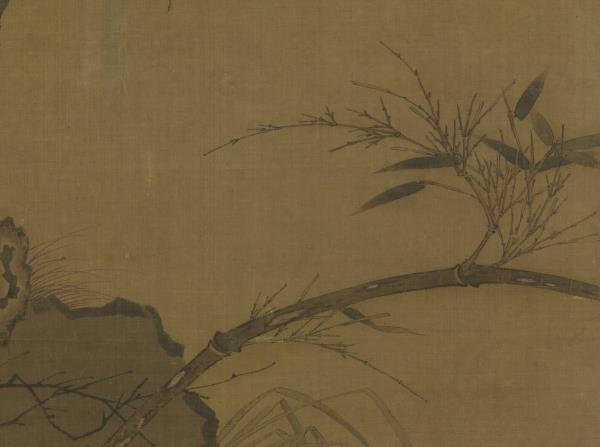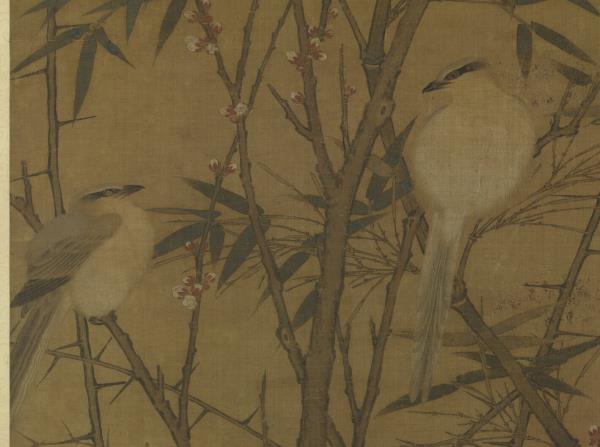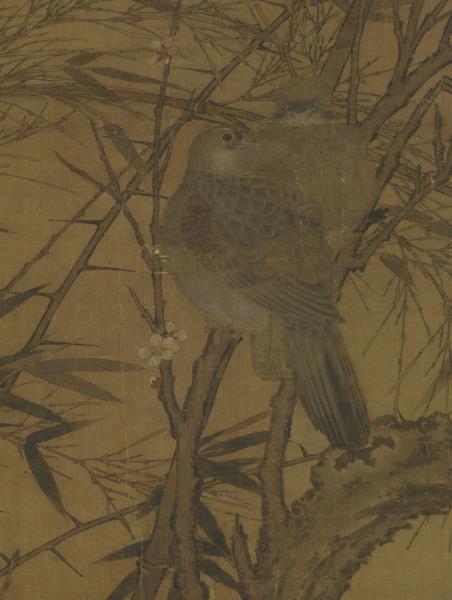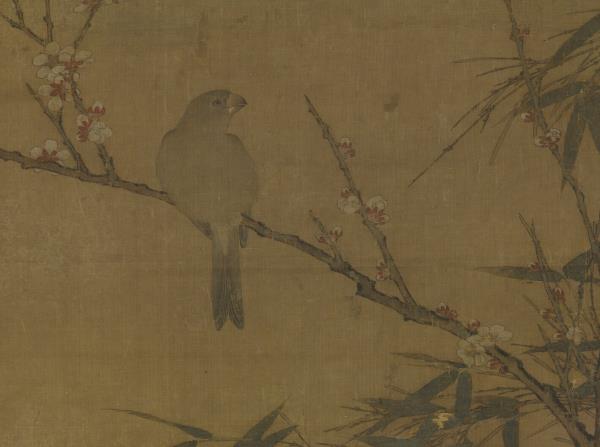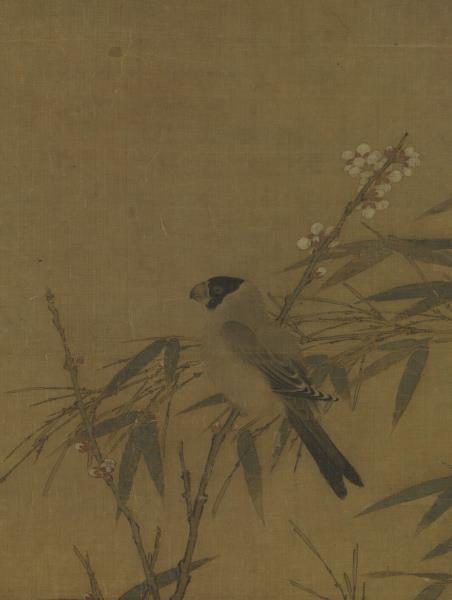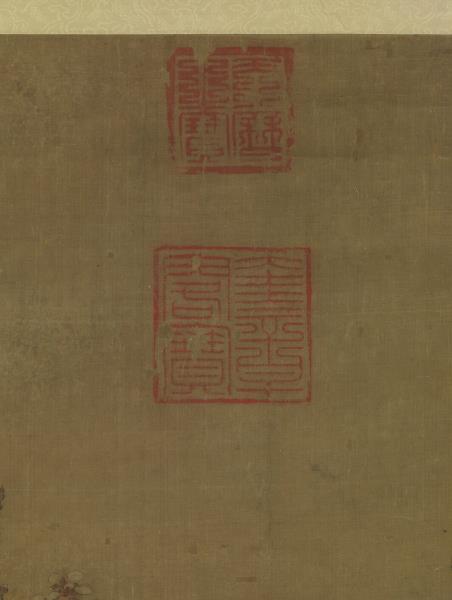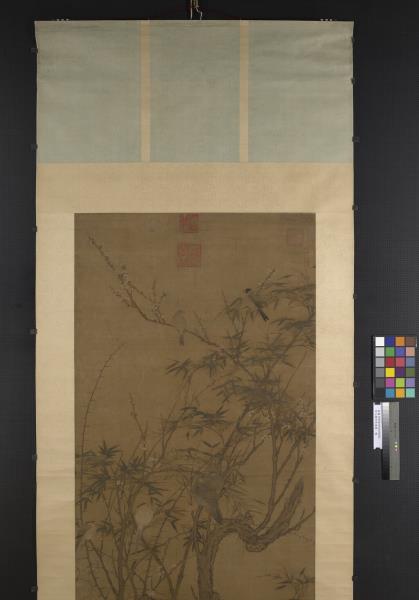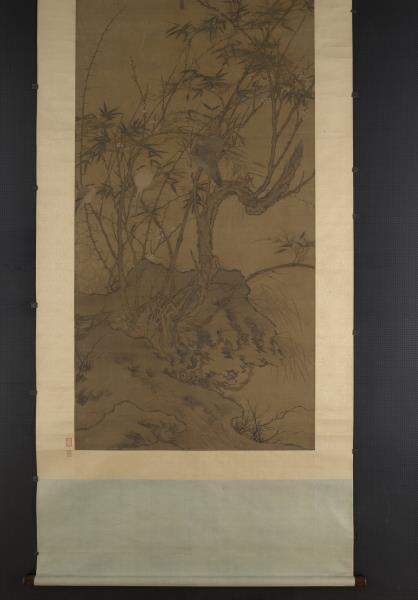| 文物統一編號 |
故畫000902N000000000
|
| 作品號 |
故畫00090200000 |
| 品名 |
宋人梅竹聚禽圖 軸
Plum Tree, Bamboo, and a Gathering of Birds |
| 分類 |
繪畫 |
| 作者 |
Anonymous |
| 數量 |
一軸 |
| 印記類別 |
印主 |
印記 |
| 收傳印記 |
|
子孫永寶 |
| 收傳印記 |
元文宗 |
天曆之寶 |
| 收傳印記 |
明官印 |
司印(半印) |
| 收傳印記 |
宋犖 |
臣犖 |
| 收傳印記 |
元文宗 |
奎章閣寶 |
| 收傳印記 |
|
欽賜臣權 |
| 收傳印記 |
宋理宗 |
緝熙殿寶 |
| 鑑藏寶璽 |
清高宗 |
石渠寶笈 |
| 鑑藏寶璽 |
宣統帝 |
宣統御覽之寶 |
| 鑑藏寶璽 |
宣統帝 |
宣統鑑賞 |
| 鑑藏寶璽 |
清高宗 |
乾隆御覽之寶 |
| 鑑藏寶璽 |
清高宗 |
御書房鑒藏寶 |
| 鑑藏寶璽 |
宣統帝 |
無逸齋精鑒璽 |
| 鑑藏寶璽 |
清仁宗 |
嘉慶御覽之寶 |
| 主題類別 |
主題(第一層) |
主題(第二層) |
主題說明 |
| 主要主題 |
花草 |
梅(白.紅.蠟梅) |
白梅
|
| 主要主題 |
樹木 |
竹 |
|
| 其他主題 |
山水 |
奇石 |
|
| 其他主題 |
花草 |
荊枝 |
|
| 其他主題 |
翎毛 |
伯勞 |
|
| 其他主題 |
翎毛 |
桑鳲 |
|
| 其他主題 |
翎毛 |
斑鳩 |
|
| 其他主題 |
翎毛 |
鵪鶉 |
|
| 類別 |
參考資料 |
| 內容簡介 |
此畫荒野陂石上,老梅著花,翠竹挺秀,棘草叢生,桑鳲、伯勞、綠鳩、鵪鶉棲息於其間。所作梅竹荊棘,枝幹老勁,花葉秀潤,各具生態。野禽翎毛尤有情趣,此乃緣於宋代為寫生之極盛時期。而宋人作畫講究神理情趣兼到,故作品無論繁簡大小,俱有天機活潑融和自然之致。 畫中構圖穩定,枝幹繁而不亂,彎曲的枝椏左來右往,不但形成富彈性與張力的線條,也給畫面帶來律動感。此圖充分展現徽宗畫院花鳥畫的美學,作者雖取材於自然,但在構圖上卻處處展現他安排的巧思;而花木禽鳥的刻劃入微,精工華美,更是細心觀察的結果。 本幅雖未署名款,以風格言,應為宋畫院之佳作。幅上有宋元內府收藏璽印。
|
| 內容簡介 |
畫郊園一景,陂石上老梅、翠竹挺秀,棘草叢生,桑鳲、綠鳩、伯勞、鵪鶉棲息其間。宋代為寫生之極盛時期,講究形神兼備,故筆法生動寫實,富轉折與流暢之變化。 畫面的整體氣氛沈靜,其中棲止的鳥類,屬靜的一面;不過繁而不亂的枝幹,形成富彈性和張力的弧型線條,則帶來了律動感。這充分表現出徽宗(1082-1135)畫院花鳥畫雖取材於自然,在構圖上卻處處展現巧思的特色。(20061206)
|
| Description |
Depicting a scene from a suburban garden, an old plum tree and emerald bamboo grow upright and elegantly on a slope interspersed with clusters of thorns and grasses, among which can be found such birds as the grosbeak, turtledove, shrike, and quail. The Sung dynasty was the golden age of realism (“sketching from life”) in Chinese painting, in which both form and spirit of the subjects were meticulously studied and rendered. Resulting in the development of animated and realistic brush methods, it involved great variation in direction and flow to the brush strokes. The overall atmosphere of this painting is somewhat static and still with a variety of birds. However, the complex (yet not chaotic) branches and trunks create flexible and tensely arcing forms that also add an element of rhythm to the composition. This clearly shows that bird-and-flower subjects produced at the Imperial Painting Academy under Emperor Hui-tsung (1082-1135), although inspired by nature, still reveal the feature of great skill and command of every facet of the composition.(20061206)
|
| Description |
A host of birds—including grosbeaks, shrikes, pigeons, and quail—has gathered in a wild thicket of bamboo and brambles dominated by an old, blossoming plum tree. The boughs and trunks of the underbrush are imbued with an enduring strength set off by the delicate moistness of the leaves and flowers. Through careful study and observation of Nature, Sung artists were able to communicate their subjects' spirit and character, and their works, regardless of scale or complexity of composition, reflect a certain sense of liveliness and animation. The composition is stable and the branches are complex, but not chaotic. The arching branches extend from right to left to carve out a space, offset the vertical arrangement, and suggest tensile force. This also gives the work rhythmic flow and movement, expressing the aesthetics of bird-and-flower painting in court painting under Hui-tsung. Taking a slice from nature, this work reveals considerable compositional skill. Furthermore, the beautifully naturalistic details of blossoms, plants, and birds reflect the artist's meticulous observation. This work bears no signature or seals that allow us to identify the artist, but stylistic considerations suggest it is a product of the Sung Imperial Painting Academy.
|
| 網頁展示說明 |
郊野的一角,老梅棘竹叢生,桑鳲、綠鳩和灰伯勞成對棲息其間,另在樹石之間還有一隻鵪鶉。畫中的植物和鳥類雖然都處在靜止的狀態,但是彎曲的枝幹所形成的數道弧線,卻使得畫面具有律動感,增添了畫面活潑的趣味。畫中禽鳥彼此互相呼應。每片鳥羽都仔細鉤勒,再敷染顏色,一絲不苟,非常寫實。畫梅幹和石頭的用筆沈緩,以碎筆點出質感;畫竹、草和荊棘以及所使用的皴法,用筆十分流暢。全作的筆法依據各種物體不同的形質靈活變化,充分反映了畫家仔細觀察自然,刻劃入微的寫實精神。 這件作品沒有畫家的款印,不知道是何人所作。可是畫中梅樹枝幹的佈局,與宋徽宗的「蠟梅山禽」十分接近,全作的筆法又和崔白(活動於十一世紀)的「雙喜圖」相似,因此推斷這件畫軸可能是宣和畫院中,屬崔白一派的畫家所作。
|
| 網頁展示說明 |
On a slope grows an old plum tree surrounded by thorns, grasses, and elegant green bamboo. Perched among them are grosbeaks, shrikes, and doves. Behind the trunk of the plum tree is a quail. The composition is stable and the branches are complex, but not chaotic. The arching branches extend from right to left to carve out a space, offset the vertical arrangement, and suggest tensile force. This also gives the work rhythmic flow and movement, expressing the aesthetics of bird-and-flower painting in court painting under Hui-tsung. Taking a slice from nature, this work reveals considerable compositional skill. Furthermore, the beautifully naturalistic details of blossoms, plants, and birds reflect the artist's meticulous observation.
|
| 收藏著錄 |
石渠寶笈初編(御書房),下冊,頁1155
|
| 收藏著錄 |
故宮書畫錄(卷五),第三冊,頁153
|
| 收藏著錄 |
故宮書畫圖錄,第三冊,頁135-136
|
| 研究性論著 |
「宋人梅竹聚禽」畫的是郊區一景。在輕風徐來時,畫家以生動寫實,或是多轉折、或是流暢的筆法,描繪出梅、竹、荊棘和坡石小草的自然型態,以及棲息其間的桑鳲、綠鳩、楔尾伯勞和鵪鶉,這屬於靜態的一面;但同時在寫生之外,更運用匠心,安排各植物的枝幹,彎曲成多道弧線,添加了律動的感覺。而不論靜與動,又都在畫面上凝結於一剎那間,呈現出一份寧靜安詳的氣氛,是典型表現宋代繪畫特色的作品之一。
若再仔細看看畫幅的右邊,會發現好像有些意猶未盡的感覺。首先是靠邊的伯勞被裁切得不太自然;下方宋理宗(1205-1264)的殿名印「緝熙殿寶」,在一般的情況下也不該會被裁切到;尤其更特別的是各鳥類都成雙出現,卻只有鵪鶉是一隻,並面朝外緣,像是在尋找著什麼。由於有這些疑點,我們因而推斷這幅畫可能因為破損,或在重新裱裝時右方被裁去了一小段,而成了今天的面目,以致鵪鶉一直在尋覓著牠失去的伴侶!(譚怡令)
|
| 參考書目 |
1.譚怡令,〈宋人梅竹聚禽圖〉,收入王耀庭、許郭璜、陳階晉編,《故宮書畫菁華特輯》(臺北:國立故宮博物院,1987年初版,2001年再版),頁164-165。
2.譚怡令,〈宋人梅竹聚禽圖 軸〉,收入林柏亭主編,《大觀-北宋書畫特展》(臺北:國立故宮博物院,2006年初版一刷),頁210-213。
3.劉芳如,〈梅竹聚禽〉,收入林柏亭主編,《國寶菁華 — 書畫‧圖書文獻篇》(臺北:國立故宮博物院,2006年12月),頁202。
4.譚怡令,〈宋人梅竹聚禽圖〉,收入譚怡令編,《畫裡珍禽》(臺北:國立故宮博物院,1988年十月初版),頁87。
5.林柏亭,〈宋人梅竹聚禽圖〉,《故宮文物月刊》,第1期(1983年4月),頁74-78。
6.譚怡令,〈宋人梅竹聚禽圖〉,《故宮文物月刊》,第100期(1991年7月),頁84。
7.劉芳如,〈宋人梅竹聚禽〉,收入蔡玫芬主編,《精彩一百 國寶總動員》(臺北:國立故宮博物院,2011年九月初版一刷),頁280。
|
| 網頁展示說明 |
本幅描繪春日的郊野一隅,白梅、翠竹、荊棘傍石叢生,枝幹彎曲、糾結,極盡變化之能。枝椏間並有桑鳲、綠鳩和楔尾伯勞成對棲息,地面猶見一隻鵪鶉低首覓食。
畫上時代最早的收傳印為南宋理宗的「緝熙殿寶」,故成作年代應不晚於北宋。《宣和畫譜》著錄李正臣其人作有〈梅竹山禽圖〉,與本件頗為相符。由於院畫多未署款,不能斷言本幅即出自李氏,但從畫風推測,本幅當為宣和畫院的作品。
(20110913)
|
| 網頁展示說明 |
This painting depicts an intimate rustic scene on a spring day with white plum blossoms, emerald bamboo, and thorns growing in profusion by rocks. The branches and stalks arc and intertwine with great variation. Interspersed and perched amongst the branches are pairs of yellow-billed grosbeaks, green pigeons, and Chinese gray shrikes, while a quail on the ground stoops over searching for food.
The earliest collection seal on the painting is “Treasure of the Qixi Hall” from Emperor Lizong of the Southern Song, indicating it does not date after the Northern Song. The imperial Xuanhe Painting Catalogue of the late Northern Song records Li Zhengchen and his painting of “Plum Blossoms, Bamboo, and Wild Birds,” which appears to be quite similar to this work. While many works of the Painting Academy were unsigned, it cannot be asserted that this work was by Li. Nonetheless, judging from the style, it appears to be from Emperor Huizong’s Xuanhe Painting Academy.
(20110913)
|
| 參考書目 |
陳韻如,〈宋人梅竹聚禽圖 軸〉,收入陳韻如主編《公主的雅集-蒙元皇室與書畫鑑藏文化特展》(臺北:國立故宮博物院,2016.10),頁86-87、266-267。
|
| 參考書目 |
國立故宮博物院編輯委員會,〈宋人梅竹聚禽圖 軸〉,收入《故宮書畫菁華特輯》(臺北:國立故宮博物院,1996.10),頁164-165。
|
本院文物保存維護依〈國立故宮博物院典藏文物管理作業要點〉及〈國立故宮博物院文物修護業務作業原則〉辦理
抽盤點紀錄
修護紀錄

